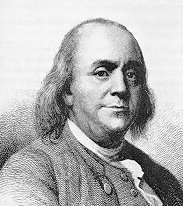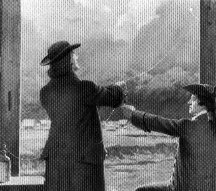

In 1743, in Boston, Benjamin Franklin was present at some electric experiments by Adam Spencer, a famous scottish professor.
Soon afterwards he asked his corrispondent from London, the naturalist Peter Collinson, to ship some glass tubes and set up a laboratory in his house.
In June 1752 B. Franklin made his famous experiment with a kite in which he proved that lightning was an electrical discharge from the clouds.
Men, before Franklin, believed that lightning were thrown from the heaven by angry gods.
Later he showed that some clouds have a positive charge and that others have a negative charge and invented the lightning rod.
William Watson (1715-1790) in 1746 suggested that there was only one "fluid". One of the two kind proposed by Du Fay could be an excess (+) of this fluid, and the other a lack (-) Flow from + to - could account the facts.
Rubbing a comb with wool transfers some natural electricity from the comb to the wool. This gives the wool extra electricity which Watson called +, or positive. The comb was left with less than its natural amount, the -, or negative charge.
When glass is rubbed with silk, the glass becomes positive and the silk negative. The attraction between unlike charge is explained by saying that the + charge tends to flow back to the -, thus restoring the natural amount of electricity in each object.
Franklin adopted Watson's "one fluid" theory, and his great reputation won universal acceptance for this view.
The term "charge" to indicate an electric status came from Franklin.
In according with Franklin theory was not possible to create or destroy an electric charge, was only possible to transfer it, this theory was good enough to explain all the facts known in his time but one: the repulsion between two bodies with a negative charge (absent of electricity ?).
Franz Ulrich Theodor Aepinus (1724-1802), director of the astronomic observatory of St, Petersbourg, suggested that the common matter repels common matter when the electricity is absent.
The controversy on the number of fluids continued to divide the scientists till when J.J.Thomson discovered the electron (1897).
The two theories (one or two fluids) were both correct.